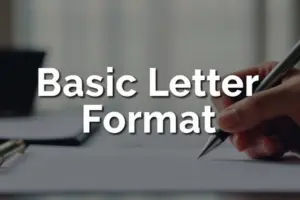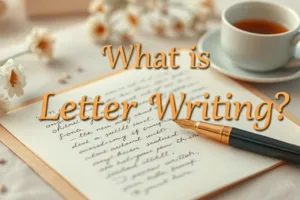How to Write a Thank You Letter: Easy Steps for Any Occasion
Published: 27 Nov 2024
Gratitude isn’t just about saying “thanks”; it’s about making someone feel special for what they did for you. I remember writing my first thank you letter to a friend who helped me during a tough time. It wasn’t perfect, but it was heartfelt and made such a lasting impression that they still talk about it today. Writing a thank you letter is more than just putting words on paper it’s a thoughtful gesture that can strengthen your connection with someone.
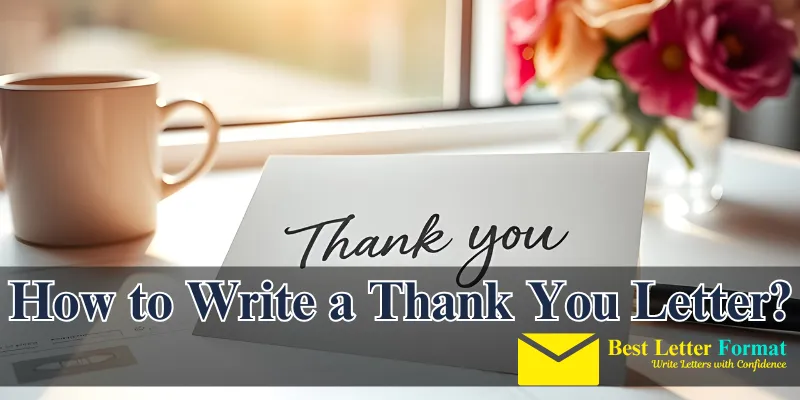
Honestly, writing one isn’t rocket science. Keep it simple, focus on being real, and add a personal touch. Whether it’s for a teacher, a colleague, or a close friend, a thank you letter shows you care in a way that feels memorable and genuine.
Think of it as an easy guide to making someone smile it doesn’t take much time, but the positive impact it leaves is worth it. So go ahead, try writing one it’s a skill that will always come in handy!
1. Step-by-Step Guide to Writing a Thank You Letter
Writing a thank you letter is more than just a polite gesture it’s a meaningful way to express your gratitude and build stronger connections. Not sure what a thank you letter means? Read about what a thank you letter is here.
Here’s how I’ve learned to craft these letters step by step:
Step 1: Decide the Format
I always start by thinking about the best way to deliver the letter. For personal occasions, like thanking a close friend, I prefer a handwritten letter because it feels more intimate and thoughtful. On the other hand, for professional scenarios, like after a job interview, an email works better because it’s quick and ensures the message reaches you promptly.
- Handwritten Letters: Great for personal and special occasions.
- Emails: Perfect for professional and urgent communication.
- Digital Notes: Ideal for casual settings or everyday gestures.
Step 2: Start with a Salutation
Using the recipient’s name makes the letter feel more personalized. I always begin with a friendly greeting like “Dear [Name]” or “Hi [Name],” depending on the level of formality. It’s a small step, but it sets the tone and creates an instant connection.
Step 3: Express Your Gratitude
This is where I focus on being specific. For example, instead of saying, “Thanks for everything,” I’d write, “Thank you for guiding me through the presentation—it boosted my confidence and helped me succeed.” When I add details, it shows that I’ve put thought into my words, making my gratitude more genuine.
Step 4: Add a Personal Touch
Whenever possible, I include a short anecdote about how their kindness or support made a real impact. For instance, “Your advice on how to improve my resume directly helped me secure my dream job.” These personal touches make the letter more meaningful and memorable.
Step 5: End with a Forward-Looking Note
I always close on a positive tone to keep the relationship open. For example, when thanking a mentor, I’ve written, “I’m looking forward to staying connected and learning more from you.” This small gesture ensures the recipient feels appreciated and leaves a lasting impression.
Step 6: Proofread and Send
Before sending, I double-check for spelling, tone, and grammar errors. A polished letter reflects effort and sincerity. I also make sure to send it promptly—timeliness matters when showing gratitude.
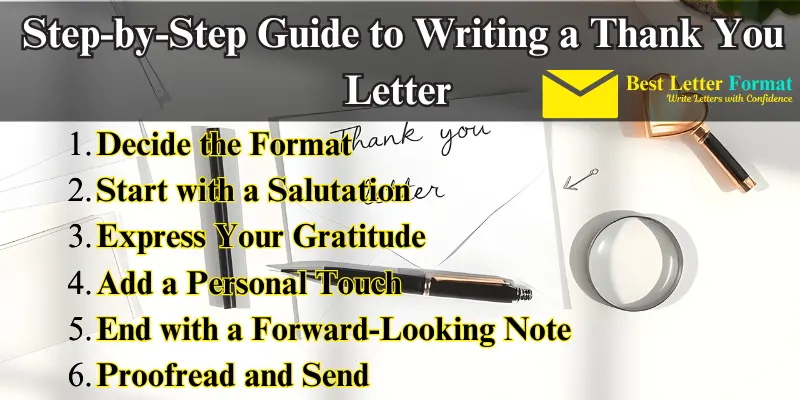
Quick Tips to Remember:
- Keep your message concise and clear.
- Always adapt the tone to suit the recipient.
- Use specific examples to make your gratitude stand out.
By following these steps, I’ve been able to write simple, heartfelt, and impactful thank-you letters. It’s a small effort, but the positive effects are long-lasting.
2. Example of How to Write a Thank You Letter
Subject: Thank You for Your Mentorship
Dear [Recipient’s Name],
I hope this message finds you well. I wanted to take a moment to express my gratitude for the invaluable guidance and support you’ve provided me over the past few months. Your insights during our project discussions helped me see challenges from a different perspective, and I truly appreciate how you made time for me despite your busy schedule.
One specific moment stands out to me—the time you reviewed my presentation and offered those actionable tips. That advice not only boosted my confidence but also resulted in a successful pitch. Your encouragement has had a lasting impact on my growth, both professionally and personally.
Looking ahead, I’m eager to stay connected and learn more from your expertise. Please let me know if there’s a way I can return the favor or contribute to any projects you’re passionate about.
Once again, thank you for everything you’ve done for me. I genuinely appreciate your mentorship and hope we can collaborate again in the future.
Warm regards,
[Your Full Name]
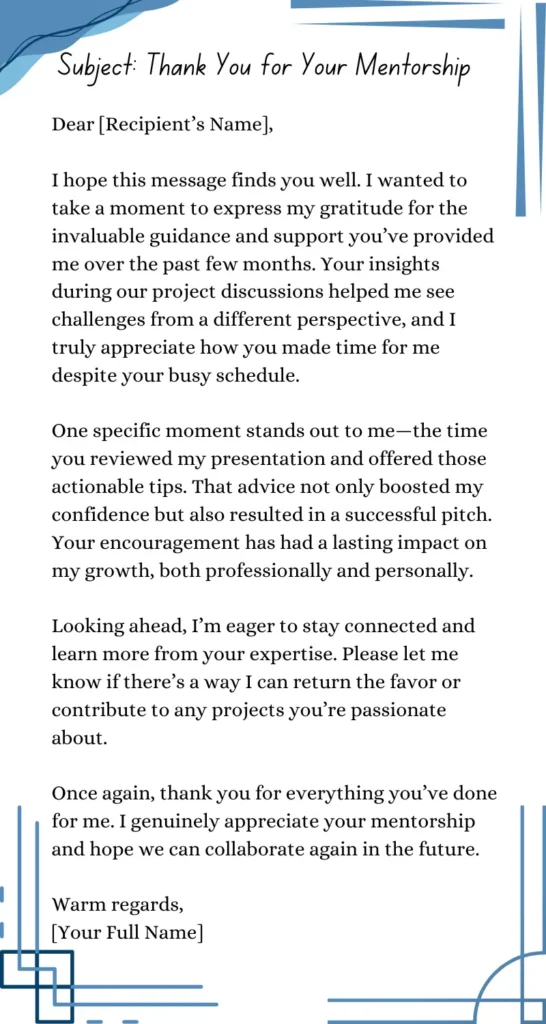
3. Tips for Crafting a Perfect Thank You Letter
When we write a thank you letter, our goal is to make it meaningful without overcomplicating things. Here’s how I ensure my letters are both effective and heartfelt:
1. Keep it Short and Sweet:
I avoid long paragraphs because no one wants to read a letter that feels like a chore. Instead, I stick to the point, making sure every sentence adds value. A concise letter feels more personal and thoughtful.
2. Use Emotion and Sincerity:
Balancing professionalism and warmth is key. I always think about how I’d feel receiving the letter and let that guide my tone. Whether it’s for a mentor or a friend, showing genuine sincerity makes the message memorable. A little emotion, when used correctly, can leave a lasting impression.
3. Include a Closing Gesture:
Ending on a positive note is something I never skip. For instance, I might say, “Let’s catch up soon!” or “Feel free to reach out anytime.” This not only wraps up the letter but also keeps the connection open for future conversations.

By following these simple tips, I make sure my thank you letters leave a positive and lasting impact. It’s a small gesture, but when done right, it goes a long way.
4. Common Mistakes to Avoid
Over the years, I’ve noticed that even with good intentions, people often make small mistakes that reduce the impact of their thank-you letters. Let me share a few I’ve learned to avoid through personal experience:
1. Being Generic
I used to think phrases like “Thanks for everything” worked just fine, but I quickly realized they sounded lazy and impersonal. Now, I focus on being specific. Instead of a generic line, I might say, “Thank you for taking the time to guide me through the project—I appreciate your patience and support.” Specificity shows you’ve put thought into your words, and it resonates much better with the recipient.
Quick Tip:
- Mention a specific action or moment you’re thankful for.
- Avoid vague phrases that could apply to anyone.
2. Delayed Responses
In my early days, I once waited weeks to send a thank you letter after an interview. By the time I sent it, the opportunity had passed, and my letter felt irrelevant. I learned that timing is everything. A prompt response shows genuine appreciation and keeps you fresh in the recipient’s mind. Now, I make it a habit to send my letters within 24-48 hours, whether it’s for an interview, a gift, or any thoughtful gesture.
Quick Tip:
- Always aim to send your letter within 1-2 days.
- Even if late, a sincere letter is better than none at all.
3. Overly Formal or Casual Tone
There was a time I wrote a letter to a client, and my tone was far too formal. It felt stiff and disconnected, and I could tell they didn’t resonate with it. On the flip side, I once wrote to a senior colleague with a tone that was too casual, and it came across as unprofessional. I’ve since learned to adjust my tone based on who I’m writing to. For formal recipients, I maintain professionalism but keep it warm. For friends or family, I let my personality shine through while keeping it sincere.
Quick Tip:
- For professional letters: Use phrases like “I truly appreciate your support on this matter.”
- For personal letters: Use conversational language like “I can’t thank you enough for your kindness.”
Avoiding these common mistakes has transformed how I write thank-you letters, making them more thoughtful and impactful. Remember, every letter is a chance to show gratitude and build stronger connections!
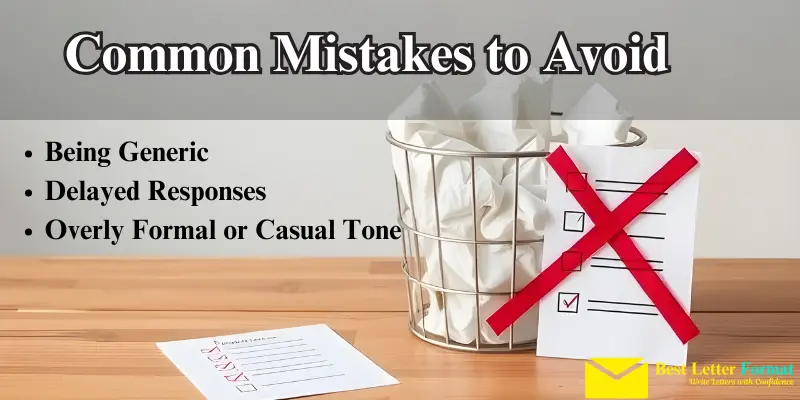
Common Frequently Asked Questions About Writing Thank You Letters
When it comes to writing thank you letters, people often have many questions about how to make their message impactful, professional, and sincere. Whether you’re expressing gratitude in a personal or professional setting, knowing the best practices can help you craft a meaningful letter. Below, we’ve compiled the most frequently asked questions to guide you through the process.
What should a thank you letter include?
A thank you letter should include a salutation, a specific expression of gratitude, a personal anecdote or detail about the recipient’s actions, and a closing note that leaves a positive impression.
What is the best format for a thank you letter?
The format depends on the occasion. Handwritten notes are ideal for personal occasions, while emails are better for professional or urgent situations.
How long should a thank you letter be?
A thank you letter should be concise, typically between 3-4 paragraphs. Focus on clarity and heartfelt expression without overloading the recipient with unnecessary details.
What tone should I use in a thank you letter?
The tone should align with the recipient and occasion. For professional settings, maintain a respectful and formal tone. For personal letters, a conversational and warm tone works best.
Can I send a thank you letter via email?
Yes, emails are widely accepted for professional thank you letters, especially after interviews or business meetings, as they ensure timely delivery.
Should I personalize my thank you letter?
Absolutely. Personalization is key to making your letter meaningful. Use the recipient’s name, mention specific actions, and explain how their efforts impacted you.
Is it better to handwrite or type a thank you letter?
Handwriting is more personal and thoughtful, making it ideal for close relationships or special occasions. Typed letters are more professional and suitable for business settings.
What common mistakes should I avoid in thank you letters?
Avoid generic phrases, delayed responses, and mismatched tones. Be specific, prompt, and thoughtful in your message to leave a positive impression.
When is the best time to send a thank you letter?
Send your letter within 24-48 hours of the event or gesture. Promptness shows that your gratitude is genuine and timely.
Can a thank you letter improve relationships?
Yes, thank you letters strengthen bonds, show appreciation, and leave lasting impressions, fostering better personal and professional relationships.
Conclusion:
So guys, in this article, we’ve covered everything you need to know about how to write a thank you letter. From choosing the right format to adding a personal touch, it’s all about showing gratitude in a way that feels meaningful and sincere. I’ve personally experienced how a simple, well-written note can leave a lasting impression—whether it’s thanking a mentor, a friend, or even a client.
Here’s a quick recommendation:
- Be personal: Use the recipient’s name and share specific details about why you’re thankful.
- Add a thoughtful touch: A short story or comment about how their actions impacted you makes your letter memorable.
- Don’t wait: Send your letter promptly to show that your appreciation is genuine.
One of my most impactful thank-you letters was sent to a mentor who helped me navigate a tough project. Writing it not only showed my gratitude but also strengthened our professional bond, proving how powerful a simple letter can be.
Now it’s your turn!
- Have you ever written a thank-you letter that stood out?
- Do you have questions about writing the perfect one?
Drop your thoughts or share your story in the comments below. I’d love to hear your experiences and answer any questions you have. Let’s inspire each other to make gratitude a part of our lives!

- Be Respectful
- Stay Relevant
- Stay Positive
- True Feedback
- Encourage Discussion
- Avoid Spamming
- No Fake News
- Don't Copy-Paste
- No Personal Attacks

- Be Respectful
- Stay Relevant
- Stay Positive
- True Feedback
- Encourage Discussion
- Avoid Spamming
- No Fake News
- Don't Copy-Paste
- No Personal Attacks



